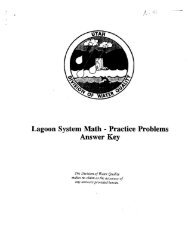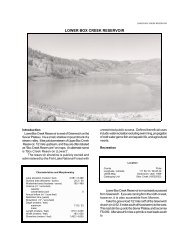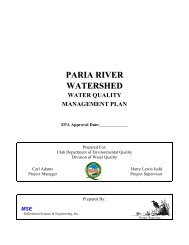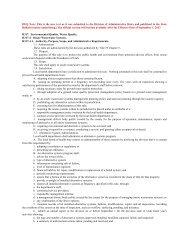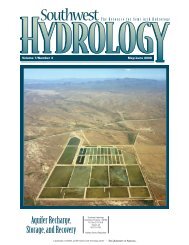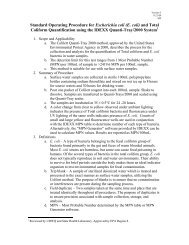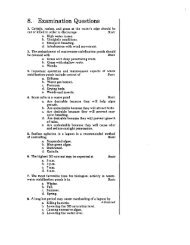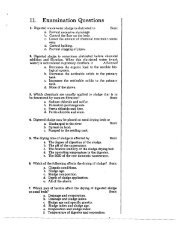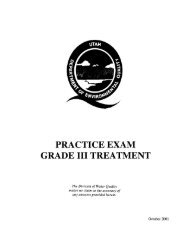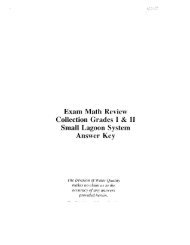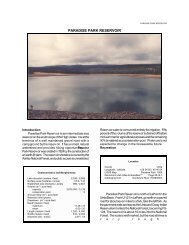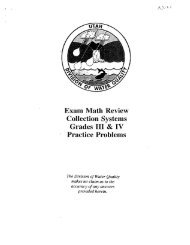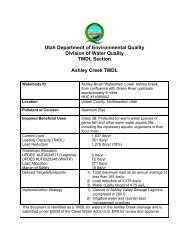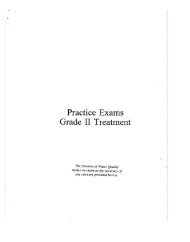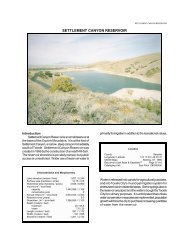Silver Creek - Division of Water Quality - Utah.gov
Silver Creek - Division of Water Quality - Utah.gov
Silver Creek - Division of Water Quality - Utah.gov
You also want an ePaper? Increase the reach of your titles
YUMPU automatically turns print PDFs into web optimized ePapers that Google loves.
<strong>Silver</strong> <strong>Creek</strong> <strong>Water</strong>shed TMDL Final Report<br />
<strong>Water</strong>shed Outlet<br />
Flows at the Wanship sampling location (above the confluence with the Weber River) average 10<br />
cfs. This corresponds to an average <strong>of</strong> approximately 7,000 acre-feet per year (AFY) leaving the<br />
watershed and entering the Weber River. Outflow from the watershed is approximately seven<br />
times less than the total amount <strong>of</strong> water coming into the watershed through precipitation,<br />
suggesting that the majority <strong>of</strong> the water exiting the system does so through mechanisms such as<br />
evapotranspiration, groundwater recharge etc.<br />
Remaining Uncertainties<br />
The following items remain unknown in this hydrologic system:<br />
• Contribution <strong>of</strong> groundwater (inflow or outflow) to various stream reaches and/or transbasin<br />
flow<br />
• <strong>Water</strong>shed evaporation<br />
• Locations and flows <strong>of</strong> irrigation diversions<br />
• Effective precipitation<br />
1.3 <strong>Water</strong> <strong>Quality</strong> Impairment<br />
The <strong>Silver</strong> <strong>Creek</strong> from the confluence with the Weber River to its headwaters is listed on <strong>Utah</strong>’s<br />
1998, 2000, and 2002 303(d) list <strong>of</strong> impaired water bodies. This waterbody is included in the<br />
“high priority” group on <strong>Utah</strong>’s 303(d) list indicating a Total Maximum Daily Load (TMDL)<br />
should be completed at this time.<br />
<strong>Water</strong> quality concerns in the <strong>Silver</strong> <strong>Creek</strong> <strong>Water</strong>shed are focused on two metals; zinc and<br />
cadmium. All indications suggest that the metals <strong>of</strong> concern in this watershed are from historical<br />
mining activities in the Park City area. Elevated concentrations <strong>of</strong> zinc and cadmium were the<br />
cause for <strong>Silver</strong> <strong>Creek</strong> being assessed as not fully supporting its Class 3A beneficial use.<br />
1.4 Effects <strong>of</strong> Zinc and Cadmium<br />
Zinc<br />
Zinc is one <strong>of</strong> the most commonly used metals in the world. Its major uses are for galvanizing<br />
steel, producing alloys, and for serving as an ingredient in rubber, ceramics, and paints. Toxic<br />
concentrations <strong>of</strong> zinc compounds cause adverse changes in the morphology and physiology <strong>of</strong><br />
fish. Acutely toxic concentrations may induce cellular breakdown <strong>of</strong> the gills and clogging <strong>of</strong> the<br />
gills with mucous. Chronically toxic concentrations <strong>of</strong> zinc compounds cause general<br />
enfeeblement and widespread histological changes to many organs. Growth and maturation are<br />
also retarded. (U.S. EPA, 1980). Some fish accumulate zinc in their bodies if they live in water<br />
containing zinc.<br />
Increased zinc concentrations will also adversely impact macroinvertebrate populations in a<br />
stream. Macroinvertebrates, which are a necessary component <strong>of</strong> the fish food chain, have been<br />
shown to exhibit adverse impacts at zinc concentrations similar to those concentrations at which<br />
fish begin to exhibit adverse impacts. (U.S. EPA, 1980). In humans, ingestion <strong>of</strong> large amounts<br />
<strong>of</strong> zinc, can cause stomach cramps, nausea, and vomiting. Zinc can also can cause anemia,<br />
Page 12



